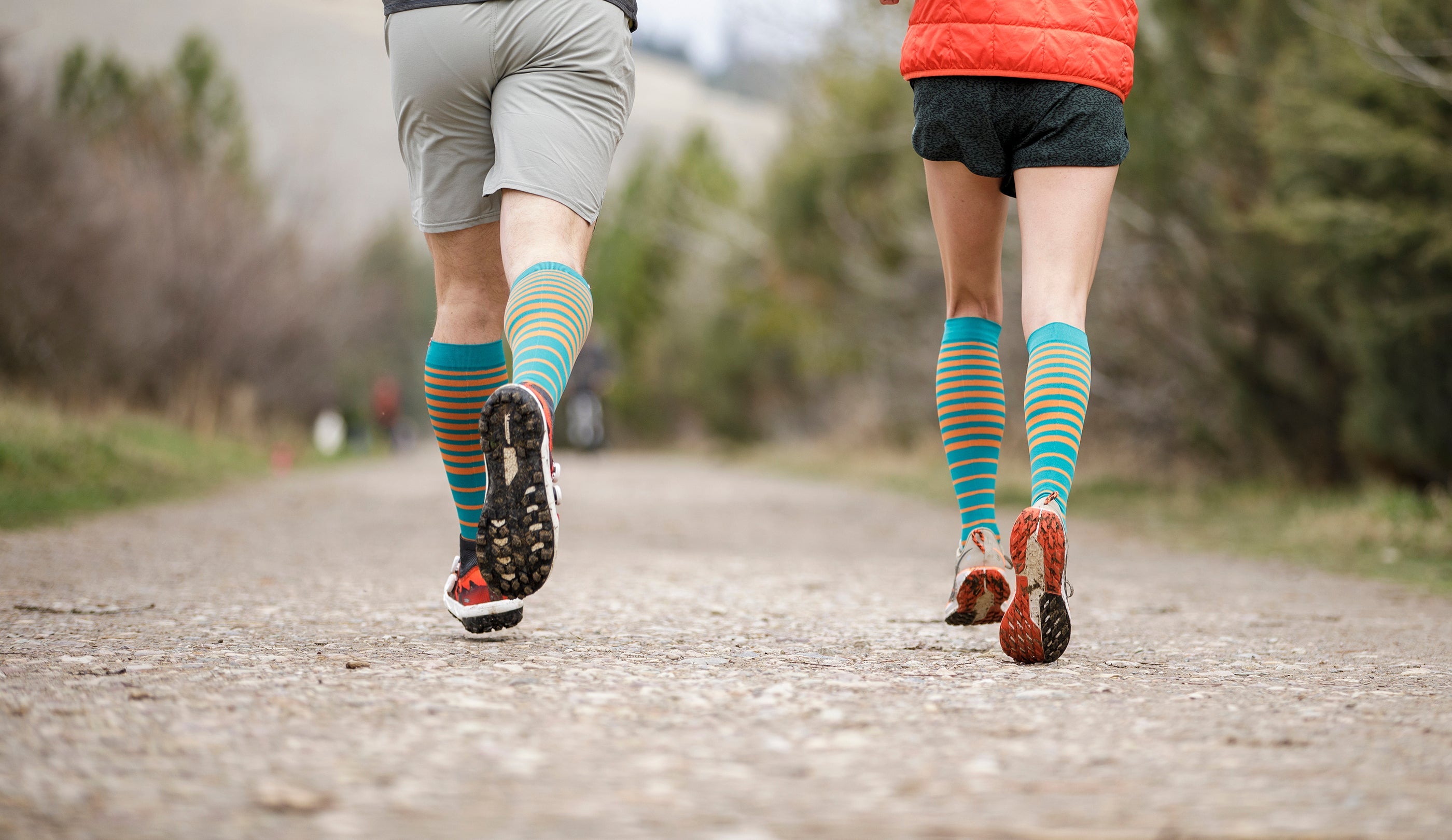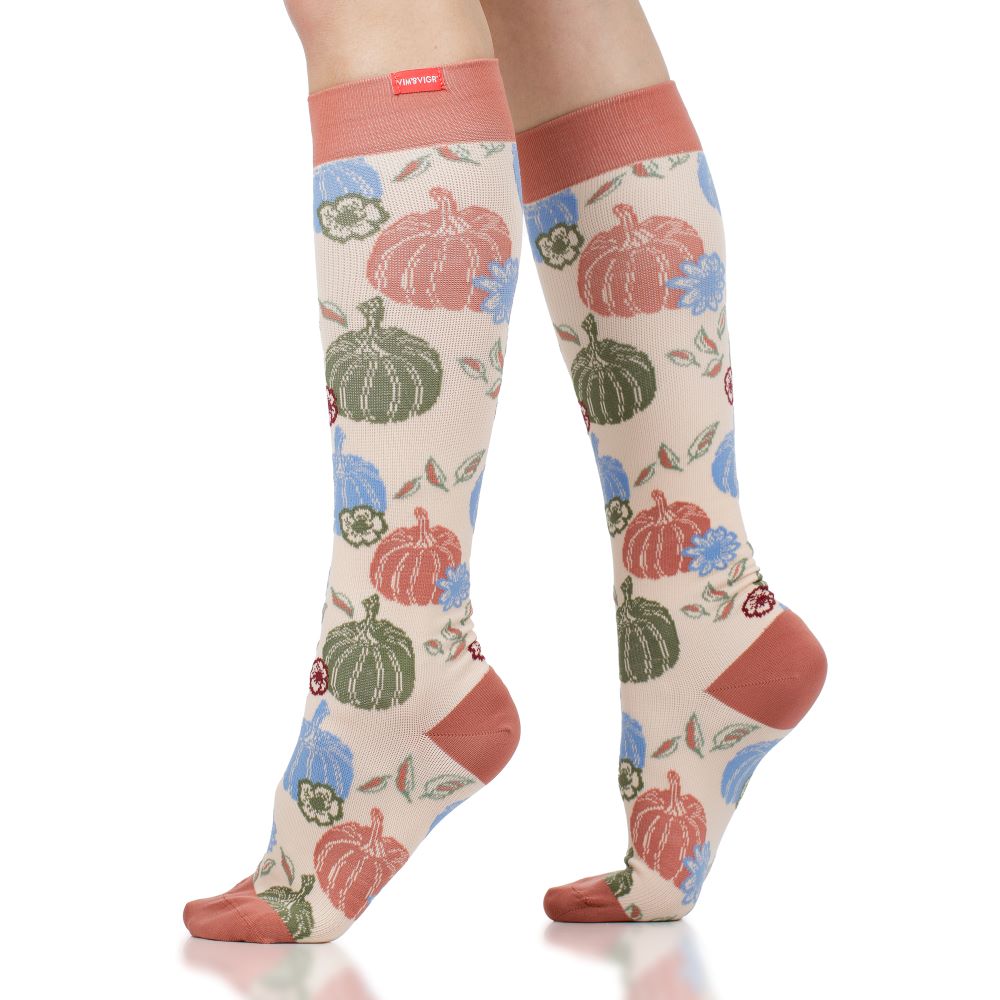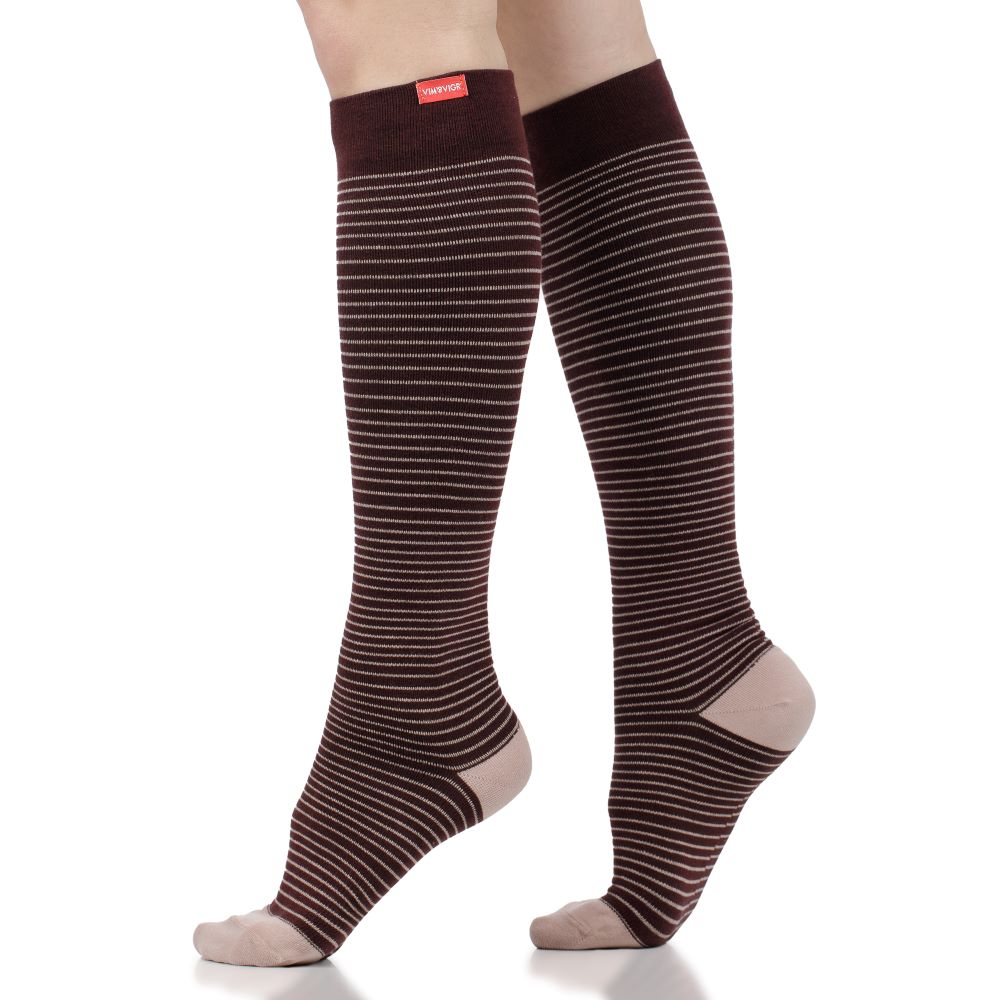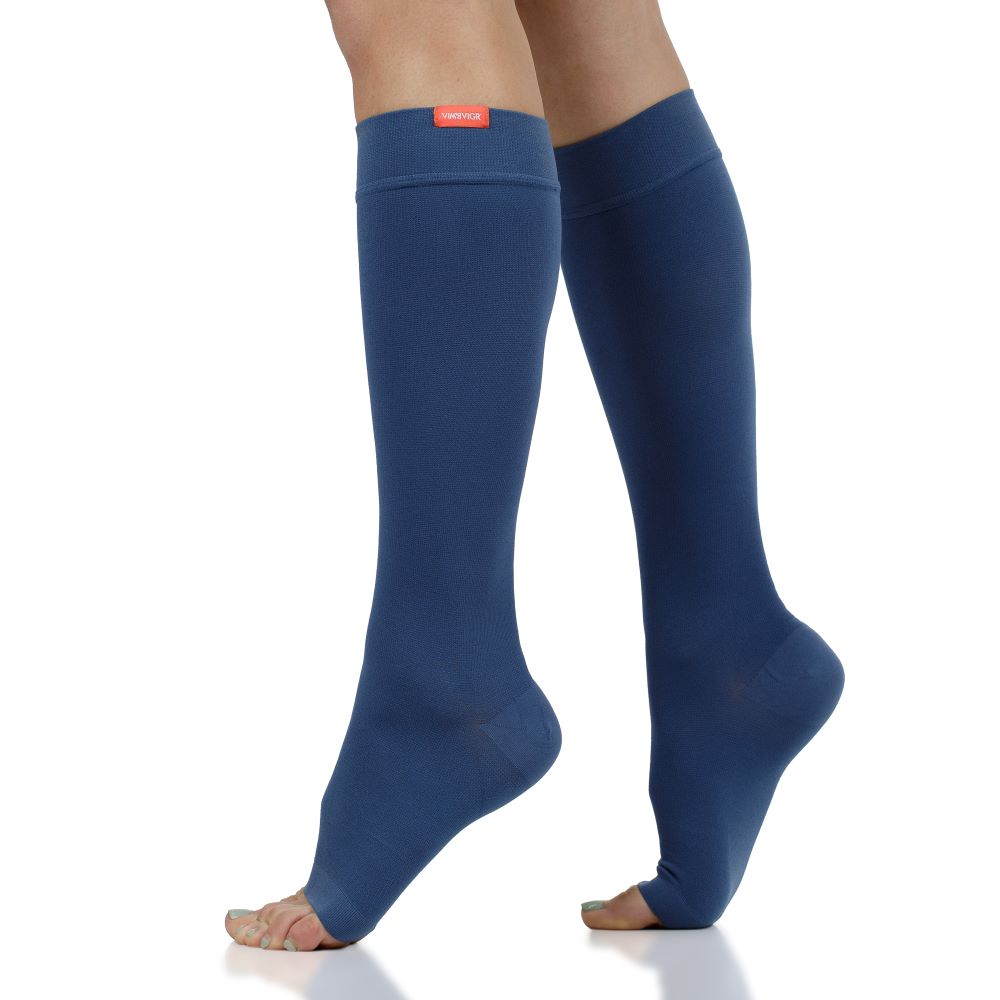What are the Benefits of Compression Socks for Sports?
Playing sports can take a serious toll on our joints and muscles. Jumping, running, quick turns and twists… they all solicit the tendons and ligaments in the lower legs, as well as the calf muscles. However, there are ways to lower the impact and enhance the enjoyment of all team and individual sports. One of these is wearing compression socks.
What are the benefits of compression socks for sports? Thanks to the pressure applied to the lower limbs, they keep legs feeling fresh and energized, prevent swelling and aches and pains, and can speed up recovery in between training sessions or after a big game.
Read on to find out all the benefits and how to wear compression socks or stockings for sports - including how to choose the best pair for you.
Are Compression Socks Good for Sports?
In one word: yes.
Compression socks have been proven to provide real benefits for recovering after sports. They can help athletes and amateurs alike, thanks to how they promote healthy blood circulation and ensure faster recovery. They also provide support for muscles and joints during sports, especially high-impact ones like basketball where you’re jumping a lot in addition to running and moving fast on the court.

The first real benefit of compression socks is on the circulatory system. The pressure that compression garments apply on the respective body part you’re wearing them on stimulates blood flow from that area towards the heart. This helps prevent build-up of fluid and blood pooling around the lower legs in the case of socks. In return, your legs will feel lighter and more energized.
The increase in blood flow also makes compression socks ideal for recovery - both from intense workouts and from injury. After hard efforts, muscles need oxygen delivered to them to help them build back up. Thanks to increased blood circulation, this is done quicker, reducing the time it takes to be ready to play your favorite sport again. Moreover, doctors often recommend the use of compression stockings when you recover from a sports injury, such as a calf strain or twisted ankle. That’s because they combine rapid delivery of oxygen to the area (promoting healing and decreasing inflammation) with added support for the joints and increased stability.
The Benefits of Compression Socks for Sports
How can compression socks deliver benefits for sports performance and recovery? Thanks to the combined action of gentle pressure and support to the area below the knee, they have lots of positive impacts, no matter what sport you play.
Enhanced Endurance and Performance
Continued delivery of oxygen to the muscles, thanks to the boosted blood flow that compression socks ensure, is key to keeping your legs fresh and energized. As a result, you can play your favorite sport for longer before your legs get sore from the effort.

Additionally, compression socks prevent water retention and swelling. This is one less negative side effect of being on your feet all day long! So, whether golfing or playing tennis in the heat, thanks to compression stockings for sports, your ankles will be free from added strain and discomfort and your legs will feel lighter.
Reduced Muscle Fatigue and Soreness
Hard efforts make your muscles sore, before they build strength. But, what if there was a way to delay fatigue and reduce soreness in your leg muscles? By supporting blood flow to the muscles, compression socks help reduce the time it takes to recover between workouts. They also help your legs feel less heavy and reduce any leg pain related to circulation issues.
Lower Risk of Sports Related Injuries
An added benefit of wearing compression socks for sports is that they provide extra support to the joints and muscles in your lower legs. The tighter grip on your ankles means there’s improved stability during sudden movements that put strain on your ligaments (such as jumping, skipping, making sudden turns). Wearing compression socks can reduce the risk of injuries such as sprained ankles.
They also reduce the effects of muscle oscillations - the tiny vibrations that go through the legs when you land against hard surfaces like pavement or tennis courts. This is a small but significant added benefit, especially over the longer term.
Faster Recovery
By improving blood circulation, compression socks also help you recover quicker in between workouts. Your leg muscles not only get the oxygen and nutrients they need quicker, thanks to better blood flow. Additionally, compression therapy helps reduce inflammation from exercise and swelling.
Reduced Swelling in the Legs and Feet
Since compression socks stimulate the blood flow within your lower legs, they prevent it from pooling by your feet and ankles. They also reduce the chance of water retention. As a result, your legs and feet are less swollen, which means you can keep playing your favorite sports for longer.

Improved Venous Function
Long periods of standing increase the risk of developing blood vessel problems such as Deep Vein Thrombosis (DVT), blood clots, etc. Thanks to not allowing blood to pool in one place and promoting its continued circulation, compression socks improve vein health overall.
How to Wear Compression Stockings for Sports
Whether you go for stockings, calf sleeves, or compression socks when you play sports, the benefits of compression are numerous. You can also choose to localize its action - for example, focusing on just your calf muscles by wearing compression calf sleeves when you want to be able to quickly change socks and shoes during an event. To make it easy to get all the benefits without wasting time and to help you keep your items in top shape for longer, here’s a guide to wearing compression stockings for sports.
Putting On and Taking Off Sports Compression Socks
It’s important to pay attention to how you put your socks on and take them off. Otherwise, you risk stretching them too much and possibly damaging them.
We’ve created a step-by-step guide to putting on compression socks here. Always ensure that your socks are well fitted and adjusted so that your heel is properly positioned in the heel pocket, while the cuff sits below the knee. This helps make sure that you’re not cutting off your circulation and getting all the benefits of compression during your game or practice.
When taking off compression socks after a game, you may be sweaty and tired. So, don’t get annoyed with them if they take a little careful manipulation! Roll your socks down patiently and don’t tug and pull at them, or you may cause damage.
Washing and Care of Sports Compression Socks
It’s relatively easy to wash and care for your socks. Merino wool socks dry quickly and are easy to re-arrange in their original shape, so you can hand wash them with gentle soap and hang them out to dry.
Generally, you should avoid any strong detergents and bleach when washing your compression socks. Go for a gentle cycle on the washing machine and hang them out to dry naturally. If you need to tumble dry them, go for a gentle, low cycle. Get more details in our guide for caring for your socks.
When to Wear Compression Socks for Sports
Your compression socks can be helpful before, during, and after sports activities. Wearing them in between practice sessions helps keep good blood flow going through your legs, preventing any swelling and reducing inflammation and pain. And, as we’ve said above, compression therapy is great for accelerating muscle recovery.

You can also wear compression socks during sports activities, especially if you’re looking to minimize the effect of muscle oscillations or to increase joint stability. They are great to wear as you recover from shin splints or plantar fasciitis. They may also prevent the onset of some sports injuries, so why not put them on during your next game?
How Long to Wear Compression Socks Before, During, and After Sports Activities
There is no set time limit to how long you should wear compression socks for sports activities. It’s really up to you and how comfortable you feel while wearing them. If you’re new to compression therapy, it’s a good idea to start with 1-2 hours at a time before your game or practice session, to become increasingly familiar with the sensation of pressure they are applying. In time, you’ll forget they’re even there, and can wear them without issues during the game, too!
After sports activities, put on your compression socks for recovery after you shower, while you relax and refuel. Again, take it slowly: start with 1-2 hours first, then gradually increase the amount of time you keep them on, depending on what feels good.
The Best Compression Socks for Sports
Now you know the many benefits of wearing compression socks before, during, and after sports activities, you’ll be wondering how to make the best choice of garments. It’s really important to get the fit and sizing right, but also to adapt the material of your socks to your activity levels and weather, among other factors. Here are the things to look out for.
Graduated Compression
The reason we offer a wide range of graduated compression socks for sports is that this is the best way to promote blood flow in the lower limbs through compression therapy. Graduated compression means that there is more pressure on your ankles, and it’s slowly decreasing as you go up the leg towards the knee. As a result, blood is pushed upwards, preventing any pooling down by the ankles.
Choose graduated compression stockings or socks, therefore, to boost lower limb circulation.
Compression Level
One key characteristic of compression socks is how tight they are - i.e., the compression level. This tells you how much pressure they’ll apply to your lower limbs and will influence how comfortable they feel, especially for a beginner.
The lightest compression level is 15-20 mmHg, a casual level of pressure that can be comfortable for all-day wear as well as for playing sports. We suggest you start with this if you’re buying your first pair.
One level up is the 20-30 mmHg range, which will feel noticeably tighter. These socks are better suited for those suffering from conditions such as edema, varicose veins, or DVT. They may be too much pressure for sports activities, but could feel good during recovery.
Medical grade compression socks come in 30-40 mmHg pressure level and are usually prescribed by a doctor. They could be part of a recovery protocol after sports injuries, but we recommend speaking to a medical expert before looking into buying this pressure level of socks.

Size and Fit
After pressure levels, the next crucial element of well-fitting compression socks is getting the right size. We’ve put together a comprehensive sizing guide to help you with this. You want your compression socks for sports to fit tightly, but also comfortably, allowing you to move freely during your activity. This is why size is so important: you don’t want your socks rolling down in the middle of a game, but you don’t want to be cutting off your circulation, either!
Material
Choose the material of your compression socks depending on the intensity of your sports activity and on the weather conditions. For hot weather or indoor training, it’s important to wear breathable fabrics that keep feet dry and avoid sweating. In the cold, your compression socks should keep you warm without being sweaty or uncomfortable, either.
Here are some key characteristics of the main materials for compression stockings and socks:
Cotton - a breathable, comfortable material that is lightweight and good for all-day wear. It can, however, retain moisture and prevent your feet from staying dry during intense activities;Nylon - this is a strong and flexible material, ideal for being able to move freely and great if you want stretchy socks that will keep up with you as you jump and turn. Nylon is also breathable;Moisture-wick Nylon - socks made from this fabric draw sweat and moisture off the skin so they’re great for hot-weather training or for humid conditions, while keeping the stretch that you get from regular Nylon;Merino wool - for unbeatable breathability and temperature regulation, Merino fibers allow the feet to stay either cool in hot weather or warm in cold weather; thanks to highly breathable fibers and moisture-wicking properties, these socks are a top choice for runners and hikers, and can be the perfect option for indoor or outdoor training alike.
Style and Type
Just because you’re wearing specialized socks, it doesn’t mean you can’t wear them in style! Check out our catalog of multiple colors and designs to add a stylish touch to your team outfit.
Finally, depending on your primary focus, you can choose between calf sleeves, compression stockings and tights, classic compression socks or even open-toe socks for those times you need to keep your toes breathing or accessorize with sandals. There are lots of different options, all designed to support your muscles and joints - and keep you performing at your best!



















Leave a comment